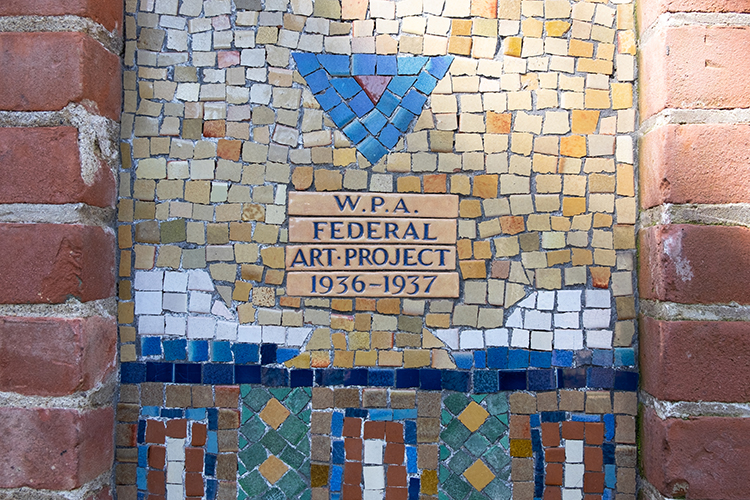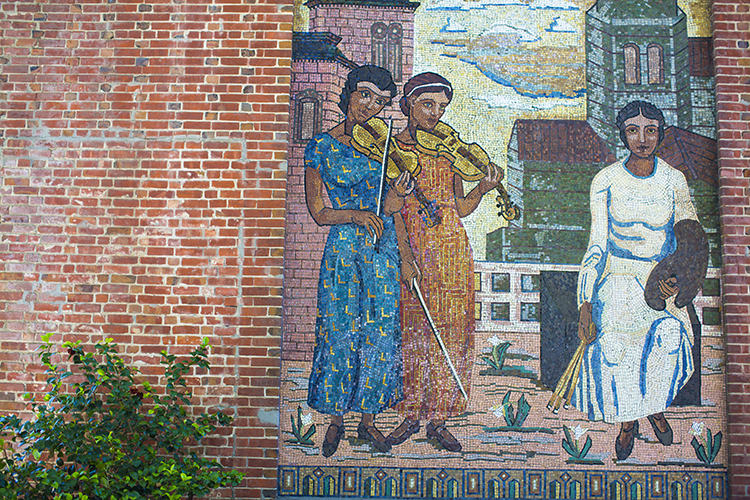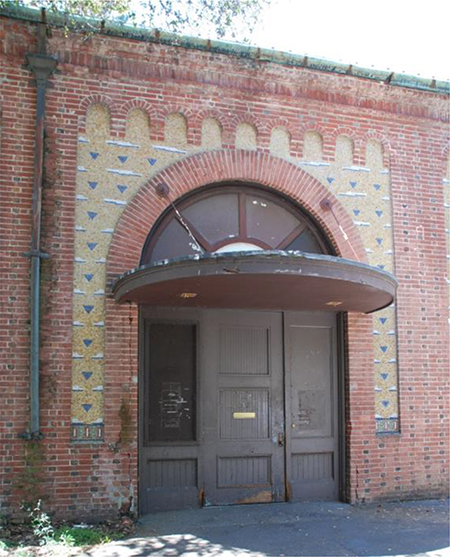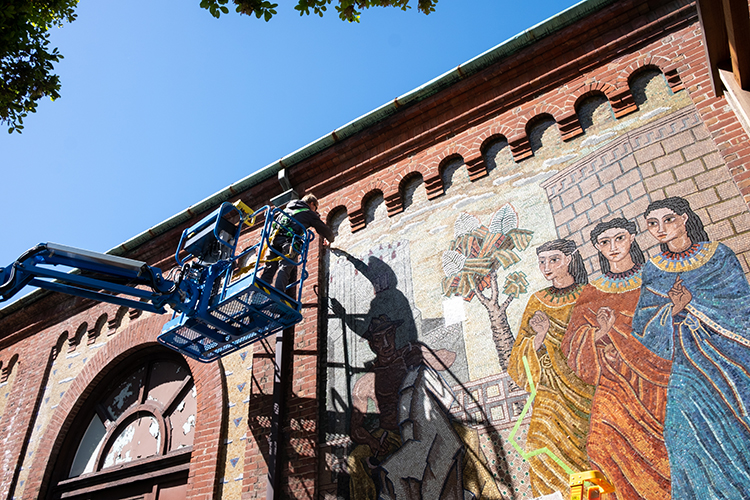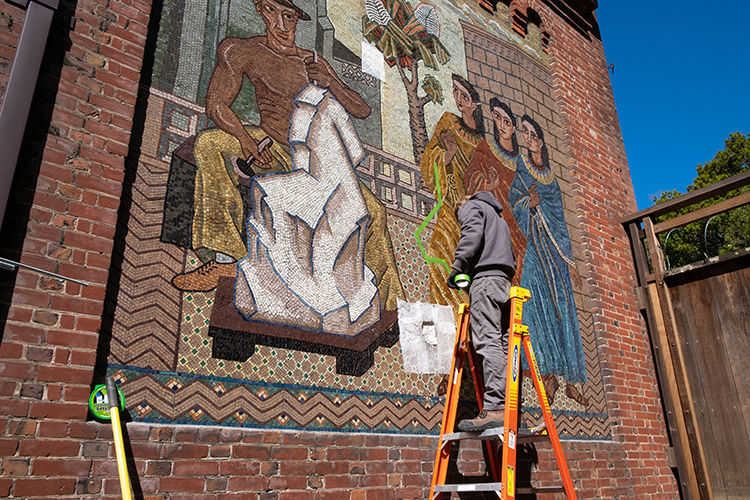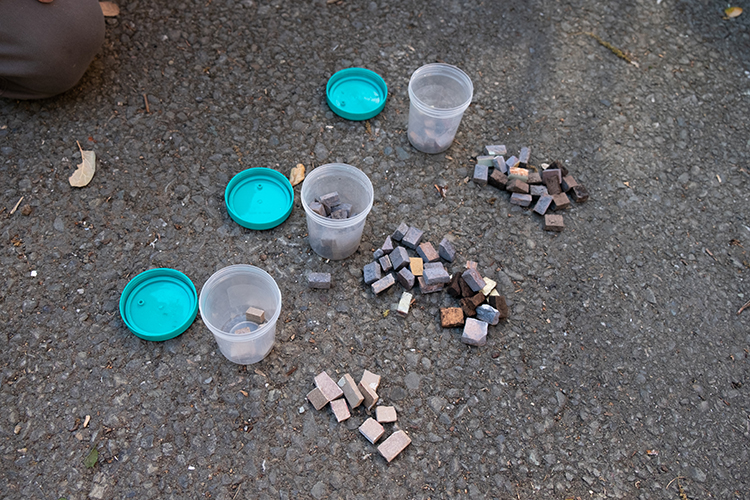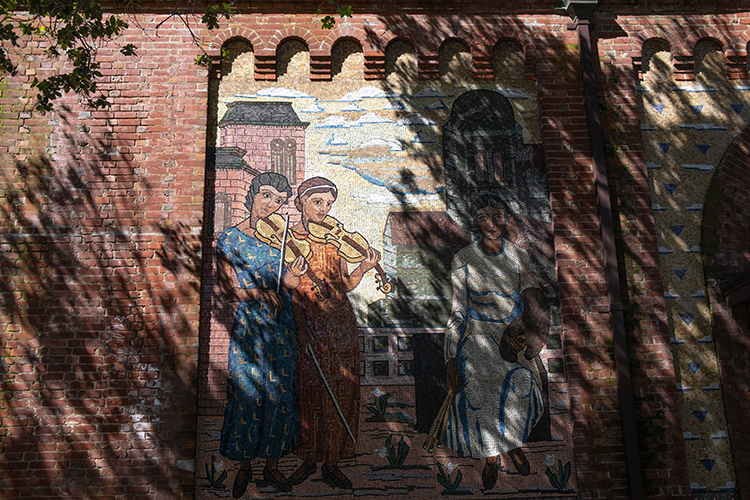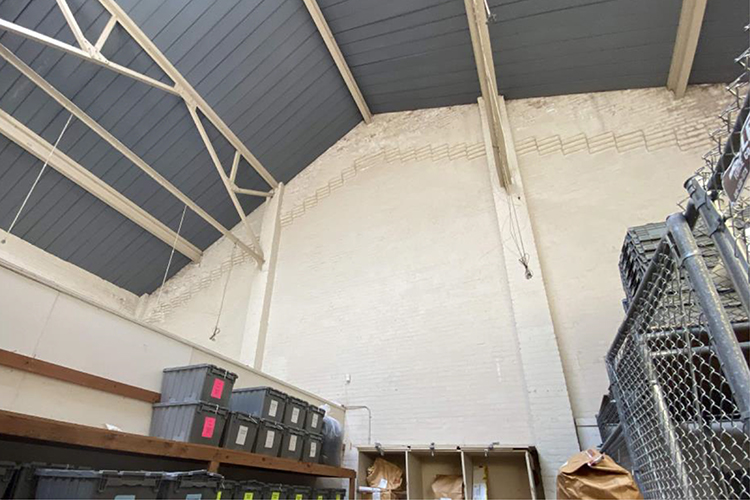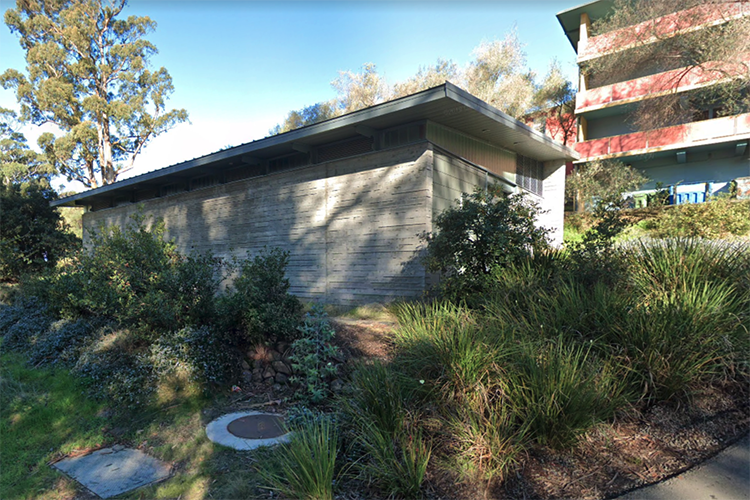Love those mosaic murals? Repairs begin on 1904 UC Berkeley building
Replacing and shoring up mosaic tiles on the Old Art Gallery is the first step toward returning it to its earliest role — as a campus power house
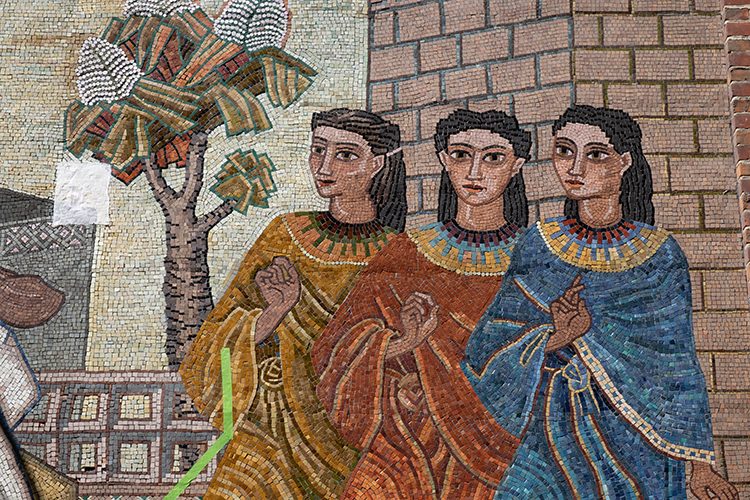
April 4, 2023

Erik Sandell, an architectural conservator, begins work to restore the massive, Byzantine-style mosaic murals on the Old Art Gallery building on campus. He is with Architectural Resources Group (ARG), the firm managing the project. (UC Berkeley photo by Sofia Liashcheva)
You’ve likely seen it on walks across the UC Berkeley campus — the little one-story red brick building northeast of Sproul Hall and near Strawberry Creek. It’s hard not to admire the colorful, Byzantine-style mosaic tile murals on its east façade that depict people playing music, dancing, painting and sculpting.
But after more than 50 years as a storage space, the decaying and largely unused 1904 structure known as the Old Art Gallery will be readied starting today for a notable new role — as Switch Station #8, the future home of electrical equipment that will route energy throughout campus.
When complete, the Romanesque Revival-style building designed by John Galen Howard, who became the UC’s supervising architect in 1901, will return to its original function as a power house. This time, however, it will serve as part of the Clean Energy Campus, a system designed to transition Berkeley to 100% clean energy by 2030.
In the coming years, a new, fully-electrified central energy plant is to be constructed beneath North Field and will allow for the shutdown and decommissioning of Berkeley’s existing natural gas-fueled cogeneration plant, a primary source of campus carbon emissions. Switch Station #8 will help distribute that energy to individual buildings.
First, though, the facility’s colorful, striking, 18-by-10-foot mosaics, installed in 1936 and 1937 during the Great Depression as part of the Works Progress Administration (WPA) program, are being repaired to preserve them for future generations.
“It is certainly fortunate that the university noticed in time that the mosaics needed conservation, so that little, if any, of the historic material was lost,” said David Wessel, principal architect at Architectural Resources Group (ARG), the firm managing the mural restoration project. “These are significant mosaics and well worth the effort to preserve, and we will be working with the material that was salvaged.”
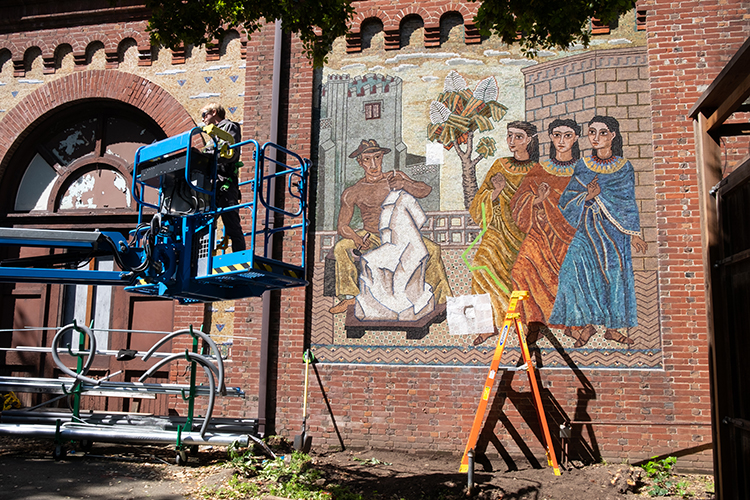
“These are significant WPA mosaics and well worth the effort to preserve,” says David Wessell, principal at Architectural Resources Group (ARG), the firm managing the mural restoration project. (UC Berkeley photo by Sofia Liashcheva)
From power house to art gallery
What eventually became the Old Art Gallery was built as the campus’s central heating and power plant, first distributing steam heat and electricity for the university more than a decade before architect Howard completed buildings including Doe Memorial Library, Hearst Memorial Mining Building, Wheeler Hall and the Campanile.
But by the end of the 1920s, the power house couldn’t keep up with the rapidly expanding institution, and a new central heating plant opened in 1930 in the southwest part of campus.
Inspired by its high ceilings and large central skylight, faculty members lobbied then-UC President Robert Gordon Sproul for the building to become a small gallery for exhibiting art. An entrance canopy was installed, and the interior was painted white. A pair of stone “Buddha’s” lions, which since the 1980s have been displayed outside Durant Hall, flanked the building’s entrance and were a gift from Albert Bender, a San Francisco art patron and benefactor.
The gallery opened in March 1934, displaying for 35 years items that included artifacts from UC benefactress Phoebe Hearst’s collections; works from China, Egypt and California’s Indigenous peoples; and student artwork.
In 1936 and 1937, four large mosaic tile murals were added to the shallow, arched niches on the eastern façade as a WPA public art project. Artist Florence Alston Swift, an abstract artist born in San Francisco in 1890 and trained on the West and East coasts, created and installed the “Music and Painting” mural. Helen Bruton, one of three artistically gifted sisters from Monterey who experimented with modernism, designed and installed the “Sculpture and Dancing” mural with her sisters, Margaret and Esther.
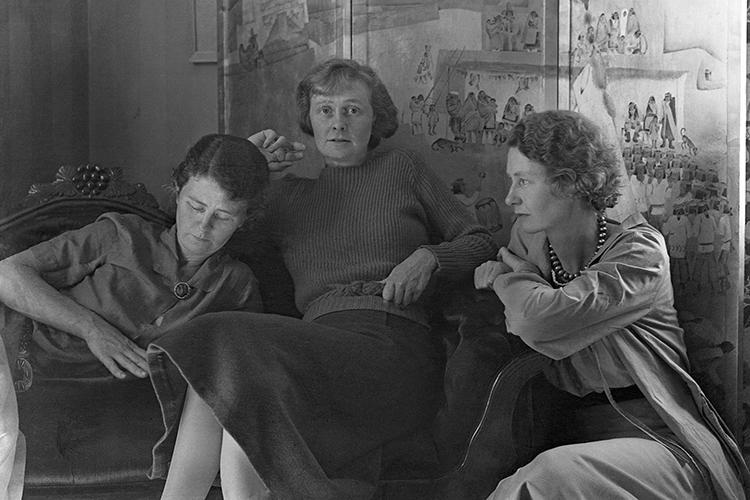
The Bruton sisters from Monterey, shown here in 1930, created the “Sculpture and Dancing” mural on the Old Art Gallery exterior. From left: Helen, Esther and Margaret Bruton. (Image: ©2023 Imogen Cunningham Trust / Courtesy www.imogencunningham.com)
As only one family member could be employed by the WPA at the time, to ensure that the money was spread around the U.S. workforce, “Bruton and her two sisters, Margaret (Marge) and Esther, completed this mural with Helen as the lead artist,” said Jim Wert, the Berkeley Capital Strategies’ project manager for the Old Art Gallery’s transformation to Switch Station #8. “Helen shared her paycheck equally with her sisters.”
The New Deal WPA program employed some 8.5 million people, who built bridges, roads, public buildings and parks and airports. It also supported tens of thousands of artists by funding more than 2,500 murals and nearly 18,000 pieces of sculpture for public buildings. The program led to the creation of the National Endowment for the Arts and the National Endowment for the Humanities.
The tiles used in the Old Art Building mosaic were from the Solon and Schemmel Tile Company in San Jose, said Wert, adding that the factory, which existed by that name from 1920-1936, “produced tiles that were inconsistent in color and texture from batch to batch,” and that the women used tile factory seconds for the Old Art Gallery mosaics.
Helen Bruton’s mural depicts a man carving a stone block with a hammer and chisel and three women dancing. The figure of the man is said to be modeled after Robert Boardman Howard, son of John Galen Howard. In the background are campus buildings.
Swift’s panel features two women with violins and a woman holding paint brushes and an artist’s palette. Swift also created the mosaic designs around the doorway and to the right side of the building.
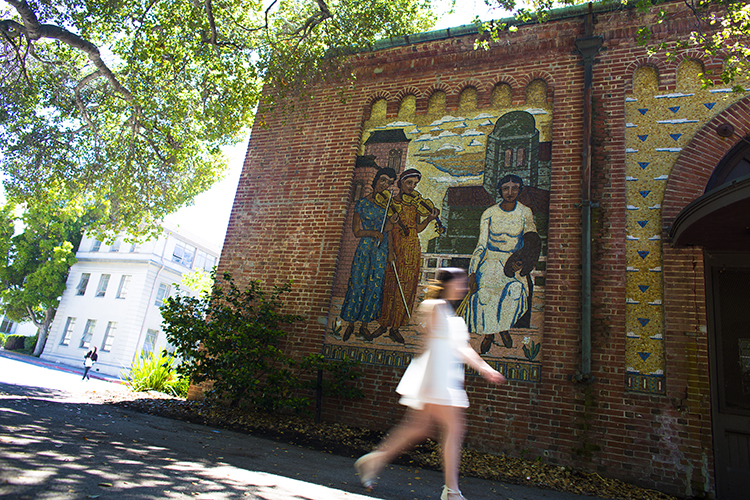
“How many buildings do we each walk by every day and not appreciate their details or know the stories of their creation? This is a special moment where the story of a building and its artwork can be shared with the campus community as we celebrate investing in saving its special elements,” says Wendy Hillis, campus architect. (UC Berkeley photo by Elena Zhukova)
A switching station again, but with history and beauty
The small art gallery closed when the mid-century, Brutalist-style University Art Museum opened in 1970 on Bancroft Way. But until 1974, it continued to be a place where art was exhibited, and it was called both the Powerhouse Gallery and the Barrow Lane Gallery. After that, it became a campus storage space for groups including the UC Police Department and the financial aid office.
Now, the building is on track to become Switch Station #8. The overall renovation and restoration of the Old Art Gallery Building will take about one year to complete.
The mosaic restoration, which is to wrap up at the end of spring semester, entails injecting adhesives to re-bond tiles to the wall, installing new pieces of tile if missing ones can’t be found, applying grout, and then covering the murals with thin paper to solidify them through the construction on the overall building that will start this summer.
Wert said that other areas of the Old Art Gallery’s exterior also will be restored, including the brick façade, the roof and the large central skylight.
Inside, structural improvements will be made so that the building meets UC Seismic Safety Policy requirements. After that, the switch station equipment will be installed, taking up a little more than half of the interior.
A new chapter then will begin in the life of one of Berkeley’s oldest buildings — as part of the campus’s model 21st century, 100% clean energy microgrid.
“One of the things I love about working on campus is reading the palimpsest of stories and marks on our landscapes and buildings,” said Assistant Vice Chancellor Wendy Hillis, campus architect. “This building has had many iterations – as a power house, as a museum, and most recently as storage. It is exciting to reinvest in adding another story and use to its history.”
By 2030, the Clean Energy Campus “will reduce our building carbon footprint by over 80%,” said Kira Stoll, the campus’s chief sustainability and carbon solutions officer. “Accomplishing this requires a new central plant and increasing our capacity for clean power to reach the campus. Of all the benefits of Switch Station #8, increasing this capacity is a major one.”
